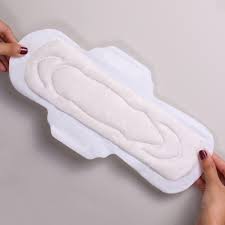With modernization and advancement, most Indian women have switched to using sanitary napkins during menstruation, replacing the cotton cloth napkins that our grandmothers used. Approximately 64% of Indian women use sanitary napkins, while the rest still use cotton cloth rags. The Government of India, through Jan Aushadhi stores, sells pads for Rs 1 per piece to the public. However, little is known about the ingredients used by manufacturers in the production of these napkins. Since sanitary napkins are classified as medical products in India, manufacturers are exempted from the regulations of the Bureau of Indian Standards (BIS) of 1980. According to the BIS regulations, every packet of sanitary napkins should include the following information:
a) Method of use: Clear instructions should be provided on how to properly use the sanitary napkin, including how to remove the adhesive backing and position the napkin correctly. b) Indication of absorbent side: It is essential to clearly indicate which side of the napkin is absorbent to ensure proper usage and prevent any discomfort or leakage. c) Disposal instructions: Instructions regarding the proper disposal of used sanitary napkins should be included. It is advisable to mention that napkins without individual coverings can be disposed of in water closets or designated disposal systems, adhering to local waste management guidelines.
Including these instructions in every packet of sanitary napkins can help users understand the product’s correct usage, prevent leakage or discomfort, and promote responsible disposal practices to maintain hygiene and environmental standards. Each carton of sanitary napkins should also be marked with the following information:
Manufacturer’s name or trademark: This helps identify the company or brand responsible for producing the sanitary napkins.
Number of sanitary napkins contained: The carton should indicate the total quantity of sanitary napkins packed inside. This allows users and retailers to easily determine the quantity of napkins available in each carton.
Size designation: The carton should specify the size of the sanitary napkins included, such as regular, large, overnight, etc. This helps users select the appropriate size based on their needs and preferences.
However, as per the BIS regulations, manufacturers are not required to mention the chemicals used in the five layers of the napkins. In recent years, it has been found that the chemicals used in Indian sanitary napkins are harmful to women’s health. A study conducted by the non-profit organization Toxics Link revealed that the leading 10 brands of sanitary napkins available in India contain two potentially harmful substances: phthalates and volatile organic compounds (VOCs). The study suggests that VOCs are primarily incorporated into sanitary pads as fragrances, adsorbents, moisture barriers, adhesives, and binders. These chemicals, such as phthalates, have the ability to easily evaporate into the air. VOCs are commonly used in various products like paints, deodorants, air fresheners, nail polish, moth repellents, fuels, and automotive products. Some of these chemicals have known adverse effects on human health. In the case of sanitary napkins, the report’s authors stated that these chemicals are used to add fragrance to the products. Additionally, phthalates are commonly included in the layers of sanitary pads to improve elasticity and gel properties. The findings, indicating high levels of chemicals linked to heart disorders, diabetes, and cancer in popular sanitary napkins sold in India, were published in a report titled ‘Menstrual Waste 2022’. The “Menstrual Waste 2022” report revealed that two of the most commonly sold sanitary pads in India were found to contain six different types of phthalates. The concentration of phthalates varied significantly, ranging from 10 to 19,600 micrograms per kilogram. In total, 12 different phthalates were detected across the various products included in the study. In 2021, the Indian sanitary pad market had an estimated value of approximately US$618.4 million. However, it is important to note that currently there is no specific legislation in place in India to regulate the presence of chemicals in sanitary products. Globally, the regulations governing the presence of chemicals in sanitary products are generally considered inadequate. Even in the case of the United States, the regulations enforced by the Food and Drug Administration (FDA) for these products are not mandatory. Countries like France, Australia, and China have significant room for improvement in their regulations. Only the European Union and South Korea have implemented legally-binding regulations in this regard. In India, currently, there is no specific legislation in place to regulate the presence of chemicals in sanitary products. The BIS does provide some basic tests for determining absorbent fillers’ surface and pad texture. However, there is no requirement to test the toxicity of ingredients used in sanitary products. This lack of regulatory framework leaves a gap in ensuring the safety and quality standards for these products in terms of chemical composition and potential health effects. Every woman using sanitary napkins has the right to know whether their napkins are free from these harmful chemicals or not. Their health matters, and thus, they have the full right to know about the products that have been solely prepared for menstrual health and hygiene. VOCs and phthalates are harmful to women’s reproductive health, and thus, they must not be used in sanitary napkins. It is a normal tendency for women to choose sanitary products that can be used for a longer time and have fragrance. However, we are not aware that these long-lasting and fragranced napkins are acting like a slow poison to our reproductive health. One should try to use biodegradable napkins for safety measures as they claim to be free from chemicals and fragrance.
It is indeed crucial for the Indian government to update the BIS, 1980 regulations concerning sanitary napkins. Sanitary napkins are commonly used by women on a regular basis and are a household necessity. Therefore, they should not be classified solely as medical products. Further research should be conducted to explore the benefits of biodegradable sanitary products for women’s menstrual health and the environment. Using biodegradable napkins is recommended, as they claim to be free from harmful chemicals and fragrances. Non-biodegradable sanitary napkins take nearly 800 years to decompose, posing a significant threat to the environment.
Dr Pyali Chatterjee is HOD, Faculty of Law, ICFAI University, Raipur, Chhattisgarh.

















